Implantable cardioverter-defibrillators (ICD)Implantable cardioverter-defibrillators (ICD)
Tachycardia refers to any heartbeat greater than 100 beats per minute. This can originate from the top of the heart and above the ventricle, and therefore is called a supraventricular tachycardia (SVT), or from the ventricle (bottom chamber). Patients may have no symptoms. This is more common with increasing age. For patients who do experience symptoms, these include palpitations, shortness of breath, dizziness and skipped beats. The patient often perceives the irregular heartbeat as very unpleasant. Loss of consciousness may result if the heart rate becomes too rapid. A heart failure implantable cardioverter-defibrillator (ICD) delivers electroshocks to terminate tachycardias.
Tachycardia refers to any heartbeat greater than 100 beats per minute. This can originate from the top of the heart and above the ventricle, and therefore is called a supraventricular tachycardia (SVT), or from the ventricle (bottom chamber). Patients may have no symptoms. This is more common with increasing age. For patients who do experience symptoms, these include palpitations, shortness of breath, dizziness and skipped beats. The patient often perceives the irregular heartbeat as very unpleasant. Loss of consciousness may result if the heart rate becomes too rapid. A heart failure implantable cardioverter-defibrillator (ICD) delivers electroshocks to terminate tachycardias.
Acticor 7
For patients with arrhythmias, ICD therapy can be an essential safety net, where it’s vital to minimize risk and improve quality of life in the long term. This is what the all-new, smaller and simpler Acticor 7 ICD systems are engineered to optimizing therapy when and where it matters. When used with Home Monitoring technology, AF can be detected earlier and both inappropriate shocks[1] and hospitalization rates can be reduced. And this has been clinically proven.
Service life of individual Acticor 7 ICDs[3]:
Acticor 7 VR-T – performs the function for up to 15 years
Acticor 7 VR-T DX – performs the function for up to 13 years
Acticor 7 DR-T – performs the function for up to 12 years
Acticor 7 HF-T – performs the function for up to 9 years
Acticor 7 HT-T QP – performs the function for up to 9 years
Acticor 7
For patients with arrhythmias, ICD therapy can be an essential safety net, where it’s vital to minimize risk and improve quality of life in the long term. This is what the all-new, smaller and simpler Acticor 7 ICD systems are engineered to optimizing therapy when and where it matters. When used with Home Monitoring technology, AF can be detected earlier and both inappropriate shocks[1] and hospitalization rates can be reduced. And this has been clinically proven.
Service life of individual Acticor 7 ICDs[3]:
Acticor 7 VR-T – performs the function for up to 15 years
Acticor 7 VR-T DX – performs the function for up to 13 years
Acticor 7 DR-T – performs the function for up to 12 years
Acticor 7 HF-T – performs the function for up to 9 years
Acticor 7 HT-T QP – performs the function for up to 9 years
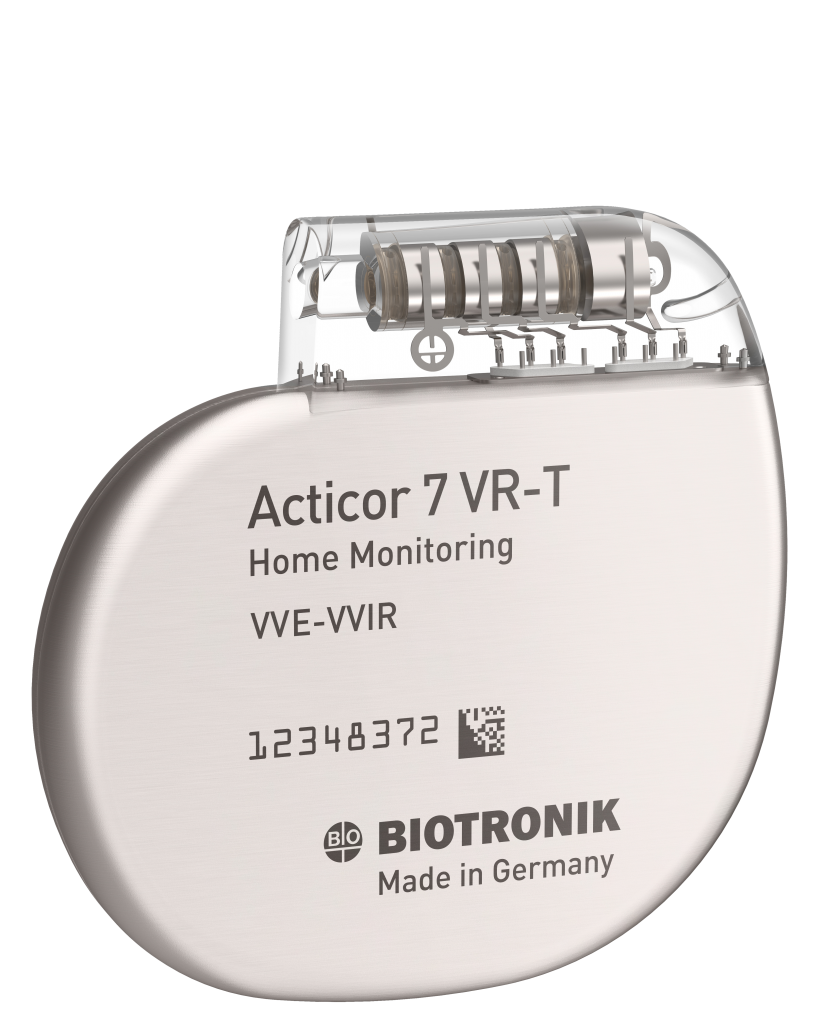
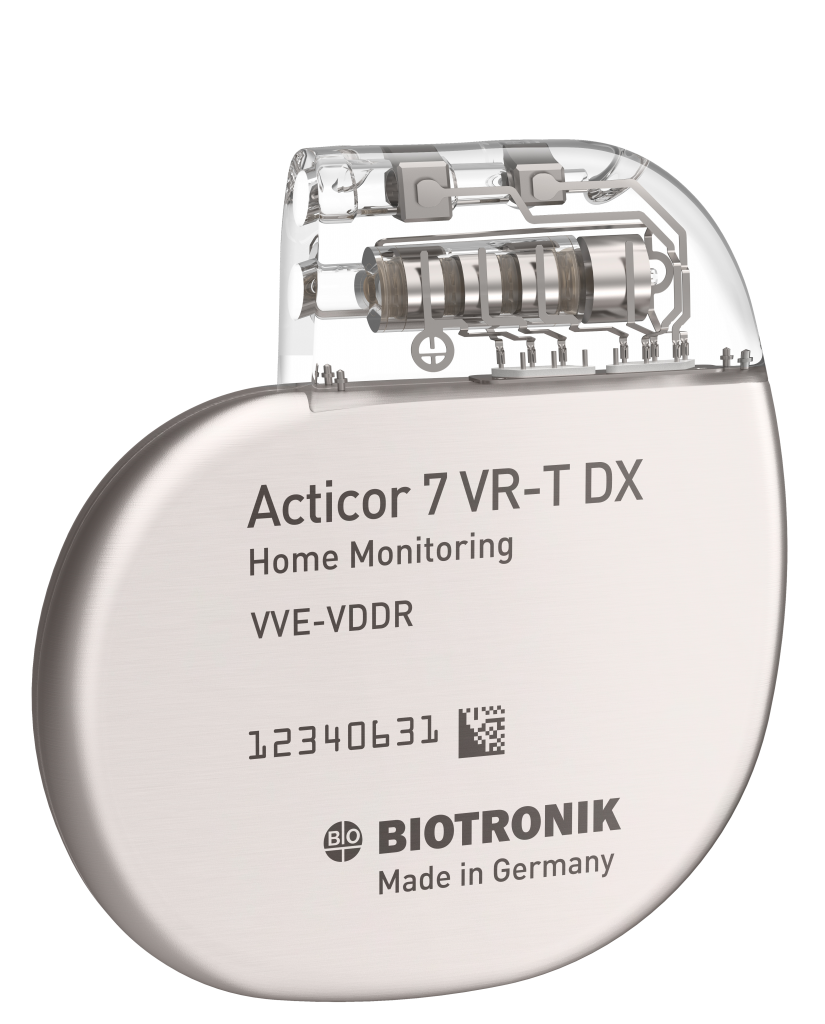
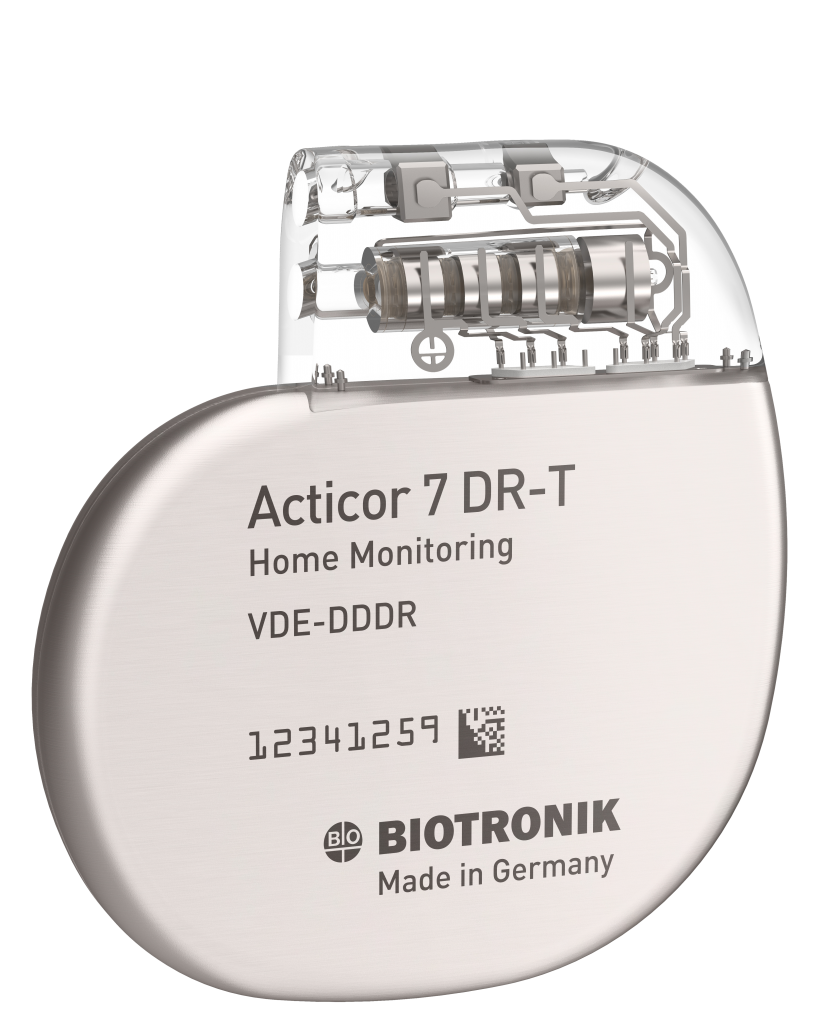







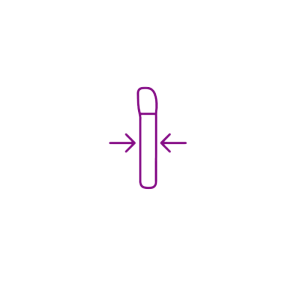
BIOshape. Ultraslim 10mm ICD.
Acticor ICDs are small and slim – only 10mm from front to back – with a smooth, elliptical, and body-friendly BIOshape[4].
- Acticor ICDs are the smallest, slimmest devices that are approved for 3T full-body MRI scans[5].
BIOshape eases implantation[6] and reduces skin pressure[7]. It helps to lower the risk of skin erosion while increasing patient comfort[8].
15 Years Longevity. 10 Years Warranty.
Acticor ICDs have an extended battery life of up to 15 years[3], supported by a full 10-year warranty
- Acticor ICDs live up to 15 years and are the smallest, slimmest 3T FBS devices that live that long[9]
This can lead to fewer box replacements and fewer procedures for patients, reducing risks, complications and costs.
- Fewer replacements means less distress for patients. The higher the remaining life expectancy, the more device replacements avoided.
- A lower number of required replacements also means lower risk of infection[10]
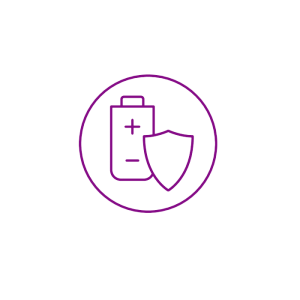
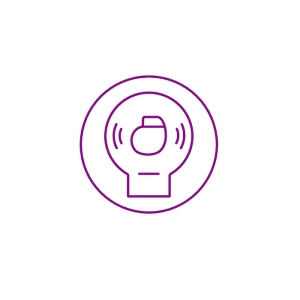
Full 3T MRI. Autodetected.
All Acticor devices feature ProMRI, which gives full and uncompromised access to high-resolution MRI, with full-body scanning and no exclusion zone.
- Full-body MRI means no exclusion zone and hence allows for the assessment of the cardiac anatomy, function and mass[11]
MRI AutoDetect senses MRI environments and self-adjusts, suspending tachycardia therapy for the duration of the scan only. This can be activated with a single visit to the physician and has a 14-day window for planning.
- MRI AutoDetect is a sensor-based technology that ensures optimal therapy and simplifies workflows in MRI.
- MRI AutoDetect can be active for up to 14 days, allowing for multiple scans and scheduling flexibility regarding time and location. It provides a complete Home Monitoring report after the scan, meaning only one in-office visit is required[12].
90 % Fewer Inappropriate Shocks
CD patients face risks associated with increased atrial burden. While atrial arrhythmias are known to be the most frequent cause of inappropriate shocks in transvenous ICDs, they also increase the risk for hospitalization and can lead to worsening of heart failure.
BIOTRONIK Home Monitoring helps physicians detect AF earlier[1]. It reduces the number of inappropriate shocks by 90%[13] and related hospitalization rates by 73%[14].
- The TRUST trial clearly shows that BIOTRONIK Home Monitoring enables physician evaluation of arrhythmias more than 30 days earlier[15]. This allows physicians to better manage atrial burden[18].
- In ECOST, a randomized study with 433 patients, BIOTRONIK Home Monitoring was highly effective in the long-term prevention of inappropriate shocks. The number of inappropriate shocks was 90% lower as compared to control[2].
- As a consequence of reducing inappropriate shocks through BIOTRONIK Home Monitoring, the number of hospitalized patients was significantly reduced by 73%[17]
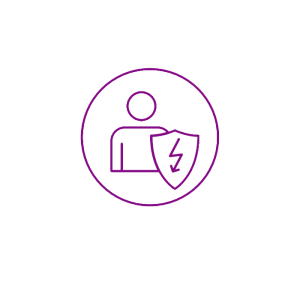
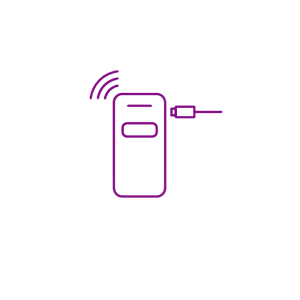
Home Monitoring works via a smartphone-sized, ‘plug in and go’ CardioMessenger Smart mobile unit, which is quick and easy to use[18] and transmits data without any patient involvement.
- BIOTRONIK’s ‘plug in and go’ solution allows for user-friendly system initialization. Data transmission is completely automatic, not requiring any active patient involvement[19], while the smartphone-sized CardioMessenger Smart transmitter makes BIOTRONIK Home Monitoring a mobile system.
- Daily, system-based transmission checks allow for industry-leading transmission success rates of 85%[20],[21].
QuickCheck gives access to patient data typically within 3 to 4 minutes[22] for more efficient treatment and greater peace of mind for patients.
- QuickCheck provides fast access to patient data. Upon the physician’s request in the Home Monitoring Service Center, data typically becomes available within 3 to 4 minutes[23].
- Patient device data can be transmitted without patient interaction.
DX Technology
All these benefits are also available with unique DX technology that provides complete atrial diagnostics with a single lead.
- BIOTRONIK’s proprietary DX technology provides dual-chamber diagnostics that combines unique sensing capabilities with a floating atrial dipole in a single-lead system. While functioning without an atrial lead, DX devices are able to detect AF.
- DX technology provides a more complete IEGM that enables better clinical decision making.
- By delivering dual-chamber SVT discrimination, it reduces inappropriate therapy[24]

BIOshape. Ultraslim 10mm ICD.
Acticor ICDs are small and slim – only 10mm from front to back – with a smooth, elliptical, and body-friendly BIOshape[4].
- Acticor ICDs are the smallest, slimmest devices that are approved for 3T full-body MRI scans[5].
BIOshape eases implantation[6] and reduces skin pressure[7]. It helps to lower the risk of skin erosion while increasing patient comfort[8].
15 Years Longevity. 10 Years Warranty.
Acticor ICDs have an extended battery life of up to 15 years[3], supported by a full 10-year warranty
- Acticor ICDs live up to 15 years and are the smallest, slimmest 3T FBS devices that live that long[9]
This can lead to fewer box replacements and fewer procedures for patients, reducing risks, complications and costs.
- Fewer replacements means less distress for patients. The higher the remaining life expectancy, the more device replacements avoided.
- A lower number of required replacements also means lower risk of infection[10]


Full 3T MRI. Autodetected.
All Acticor devices feature ProMRI, which gives full and uncompromised access to high-resolution MRI, with full-body scanning and no exclusion zone.
- Full-body MRI means no exclusion zone and hence allows for the assessment of the cardiac anatomy, function and mass[11]
MRI AutoDetect senses MRI environments and self-adjusts, suspending tachycardia therapy for the duration of the scan only. This can be activated with a single visit to the physician and has a 14-day window for planning.
- MRI AutoDetect is a sensor-based technology that ensures optimal therapy and simplifies workflows in MRI.
- MRI AutoDetect can be active for up to 14 days, allowing for multiple scans and scheduling flexibility regarding time and location. It provides a complete Home Monitoring report after the scan, meaning only one in-office visit is required[12].
90 % Fewer Inappropriate Shocks
CD patients face risks associated with increased atrial burden. While atrial arrhythmias are known to be the most frequent cause of inappropriate shocks in transvenous ICDs, they also increase the risk for hospitalization and can lead to worsening of heart failure.
BIOTRONIK Home Monitoring helps physicians detect AF earlier[1]. It reduces the number of inappropriate shocks by 90%[13] and related hospitalization rates by 73%[14].
- The TRUST trial clearly shows that BIOTRONIK Home Monitoring enables physician evaluation of arrhythmias more than 30 days earlier[15]. This allows physicians to better manage atrial burden[18].
- In ECOST, a randomized study with 433 patients, BIOTRONIK Home Monitoring was highly effective in the long-term prevention of inappropriate shocks. The number of inappropriate shocks was 90% lower as compared to control[2].
- As a consequence of reducing inappropriate shocks through BIOTRONIK Home Monitoring, the number of hospitalized patients was significantly reduced by 73%[17]


Home Monitoring works via a smartphone-sized, ‘plug in and go’ CardioMessenger Smart mobile unit, which is quick and easy to use[18] and transmits data without any patient involvement.
- BIOTRONIK’s ‘plug in and go’ solution allows for user-friendly system initialization. Data transmission is completely automatic, not requiring any active patient involvement[19], while the smartphone-sized CardioMessenger Smart transmitter makes BIOTRONIK Home Monitoring a mobile system.
- Daily, system-based transmission checks allow for industry-leading transmission success rates of 85%[20],[21].
QuickCheck gives access to patient data typically within 3 to 4 minutes[22] for more efficient treatment and greater peace of mind for patients.
- QuickCheck provides fast access to patient data. Upon the physician’s request in the Home Monitoring Service Center, data typically becomes available within 3 to 4 minutes[23].
- Patient device data can be transmitted without patient interaction.
DX Technology
All these benefits are also available with unique DX technology that provides complete atrial diagnostics with a single lead.
- BIOTRONIK’s proprietary DX technology provides dual-chamber diagnostics that combines unique sensing capabilities with a floating atrial dipole in a single-lead system. While functioning without an atrial lead, DX devices are able to detect AF.
- DX technology provides a more complete IEGM that enables better clinical decision making.
- By delivering dual-chamber SVT discrimination, it reduces inappropriate therapy[24]
[1] Varma N et al. Efficacy and Safety of Automatic Remote Monitoring for Implantable Cardioverter-Defibrillator Follow-Up: The Lumos-T Safely Reduces Routine Office Device Follow-Up (TRUST) Trial. Circulation, 2010;122: 325 – 332.
[2] Guedon-Moreau L et al. Decreased delivery of inappropriate shocks achieved by remote monitoring of ICD: a substudy of the ECOST trial. J Cardiovasc Electrophysiol, 25 (2014), 763-770.
[3] Single-Chamber ICD Standard conditions. Data on file (service time calculation)
[4] Contoured housing; Acticor/Rivacor VR: 60×61.5×10 mm; 30 ccm
[5] as part of an MR conditional system
[6] Post-Market observation; interim-analysis, December 21, 2018. Data on file.
[7] Device shape analysis, February 2019. Data on file.
[8] Post-Market observation; interim-analysis, December 21, 2018. Data on file
[9] Acticor/Rivacor Single-Chamber ICD @ 60 ppm, 15% pacing, 2.5V, 500 Ohms: Medtronic 3T FBS; VISIA AF (EVERA; MIRRO) MRI S VR SureScan: 10.7 years (MDT IFU) vs Acticor 7 VR-T ProMRI: 14.9 years. Competitor device manuals as of Nov. 2018
[10] Polyzos KA, Konstantelias AA, Falagas ME, Risk factors for cardiac implantable electronic device infection: A systematic review and meta-analysis, Europace (2015) 17, 767-777
[11] Fact file: Cardiac Imaging with MRI, CT and Nuclear Techniques British Heart Foundation. January 2010
[12] When patients are monitored by BIOTRONIK Home Monitoring. See ProMRI(R) manual for all details
[13] Guedon-Moreau L et al. Decreased delivery of inappropriate shocks achieved by remote monitoring of ICD: a substudy of the ECOST trial. J Cardiovasc Electrophysiol, 25 (2014), 763-770
[14] Guedon-Moreau L et al. Decreased delivery of inappropriate shocks achieved by remote monitoring of ICD: a substudy of the ECOST trial. J Cardiovasc Electrophysiol, 25 (2014), 763-770
[15] Varma N et al. Efficacy and Safety of Automatic Remote Monitoring for Implantable Cardioverter-Defibrillator Follow-Up: The Lumos-T Safely Reduces Routine Office Device Follow-Up (TRUST) Trial. Circulation, 2010;122: 325 – 332
[16] Schwab JO et al. Clinical Course of Dual-Chamber Implantable Cardioverter-Defibrillator Recipients followed by Cardiac Remote Monitoring: Insights from the LION Registry. BioMed Research International, 2018, https://doi.org/10.1155/2018/3120480
[17] Guedon-Moreau L et al. Decreased delivery of inappropriate shocks achieved by remote monitoring of ICD: a substudy of the ECOST trial. J Cardiovasc Electrophysiol, 25 (2014), 763-770
[18] Ricci R P et al. Long-term patient acceptance of and satisfaction with implanted device remote monitoring. Europace (2010) 12, 674-679
[19] Ricci R P et al. Long-term patient acceptance of and satisfaction with implanted device remote monitoring. Europace (2010) 12, 674-679
[20] Hindricks G et al. Implant-based multiparameter telemonitoring of patients with heart failure (IN-TIME): a randomised controlled trial. The Lancet. 2014; 384 (9943): 583–590
[21] vs. 55% – Crossley G H et al. The CONNEXT (Clinical Evaluation of Remote Notification to Reduce Time to Clinical Decision) Trial. JACC. 2011; 57(10):1181-1189 [for bar chart comparison only]
[22] Performance analysis. Data on file, 2018
[23] Performance analysis. Data on file, 2018
[24] Kurt M et al. Avoiding inappropriate therapy of single-lead implantable cardioverter defibrillator by atrial-sensing electrodes. Journal of Cardiovasc. Electrophysiol. 2018; 29(12): 1682-1689
[1] Varma N et al. Efficacy and Safety of Automatic Remote Monitoring for Implantable Cardioverter-Defibrillator Follow-Up: The Lumos-T Safely Reduces Routine Office Device Follow-Up (TRUST) Trial. Circulation, 2010;122: 325 – 332.
[2] Guedon-Moreau L et al. Decreased delivery of inappropriate shocks achieved by remote monitoring of ICD: a substudy of the ECOST trial. J Cardiovasc Electrophysiol, 25 (2014), 763-770.
[3] Single-Chamber ICD Standard conditions. Data on file (service time calculation)
[4] Contoured housing; Acticor/Rivacor VR: 60×61.5×10 mm; 30 ccm
[5] as part of an MR conditional system
[6] Post-Market observation; interim-analysis, December 21, 2018. Data on file.
[7] Device shape analysis, February 2019. Data on file.
[8] Post-Market observation; interim-analysis, December 21, 2018. Data on file
[9] Acticor/Rivacor Single-Chamber ICD @ 60 ppm, 15% pacing, 2.5V, 500 Ohms: Medtronic 3T FBS; VISIA AF (EVERA; MIRRO) MRI S VR SureScan: 10.7 years (MDT IFU) vs Acticor 7 VR-T ProMRI: 14.9 years. Competitor device manuals as of Nov. 2018
[10] Polyzos KA, Konstantelias AA, Falagas ME, Risk factors for cardiac implantable electronic device infection: A systematic review and meta-analysis, Europace (2015) 17, 767-777
[11] Fact file: Cardiac Imaging with MRI, CT and Nuclear Techniques British Heart Foundation. January 2010
[12] When patients are monitored by BIOTRONIK Home Monitoring. See ProMRI(R) manual for all details
[13] Guedon-Moreau L et al. Decreased delivery of inappropriate shocks achieved by remote monitoring of ICD: a substudy of the ECOST trial. J Cardiovasc Electrophysiol, 25 (2014), 763-770
[14] Guedon-Moreau L et al. Decreased delivery of inappropriate shocks achieved by remote monitoring of ICD: a substudy of the ECOST trial. J Cardiovasc Electrophysiol, 25 (2014), 763-770
[15] Varma N et al. Efficacy and Safety of Automatic Remote Monitoring for Implantable Cardioverter-Defibrillator Follow-Up: The Lumos-T Safely Reduces Routine Office Device Follow-Up (TRUST) Trial. Circulation, 2010;122: 325 – 332
[16] Schwab JO et al. Clinical Course of Dual-Chamber Implantable Cardioverter-Defibrillator Recipients followed by Cardiac Remote Monitoring: Insights from the LION Registry. BioMed Research International, 2018, https://doi.org/10.1155/2018/3120480
[17] Guedon-Moreau L et al. Decreased delivery of inappropriate shocks achieved by remote monitoring of ICD: a substudy of the ECOST trial. J Cardiovasc Electrophysiol, 25 (2014), 763-770
[18] Ricci R P et al. Long-term patient acceptance of and satisfaction with implanted device remote monitoring. Europace (2010) 12, 674-679
[19] Ricci R P et al. Long-term patient acceptance of and satisfaction with implanted device remote monitoring. Europace (2010) 12, 674-679
[20] Hindricks G et al. Implant-based multiparameter telemonitoring of patients with heart failure (IN-TIME): a randomised controlled trial. The Lancet. 2014; 384 (9943): 583–590
[21] vs. 55% – Crossley G H et al. The CONNEXT (Clinical Evaluation of Remote Notification to Reduce Time to Clinical Decision) Trial. JACC. 2011; 57(10):1181-1189 [for bar chart comparison only]
[22] Performance analysis. Data on file, 2018
[23] Performance analysis. Data on file, 2018
[24] Kurt M et al. Avoiding inappropriate therapy of single-lead implantable cardioverter defibrillator by atrial-sensing electrodes. Journal of Cardiovasc. Electrophysiol. 2018; 29(12): 1682-1689

